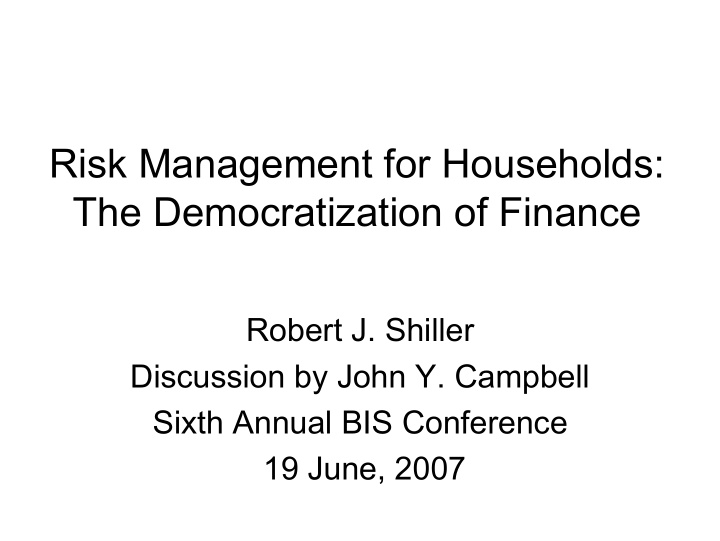



Risk Management for Households: The Democratization of Finance Robert J. Shiller Discussion by John Y. Campbell Sixth Annual BIS Conference 19 June, 2007
The Questions • What are the barriers to household risksharing? • Is the problem a lack of suitable financial instruments, or something deeper? • How is the retail financial system evolving?
Barriers to Risksharing • Adverse selection • Moral hazard • Credit problems of insurers • Credit problems of households • Consumer confusion • Shrouded equilibrium • Counterproductive regulation
Adverse Selection • Examples: – Annuities – Health insurance • Some familiar solutions: – Product bundling – Universal or group insurance
Moral Hazard • Examples: – Sharing house price risks – Sharing income risks • A familiar solution: insure only group risk, not idiosyncratic risk
Credit Problems of Insurers • Example: annuities (DB pensions) insure longevity risk which is resolved over many years • Can households trust that annuity (DB pension) payments will be made? • Partial solutions: – Insurance/pension regulation and government guarantee – Reinsurance contracts and longevity bonds – Pool idiosyncratic longevity risk (tontine) – Trade aggregate risk with mark-to-market payments (futures contracts)
Credit Problems of Households • The main asset for households is human capital which cannot be collateralized • Thus households face borrowing constraints • Example: a young household takes a long position in house price futures • What happens if house prices fall? – Forward contract exposes the counterparty to household default – Futures contract leads to margin calls and the household’s position is closed out – Macro security requires investment of liquid assets
Consumer Confusion • Examples: – Inflation illusion leads to disinterest in inflation- indexed contracts – Many households fail to prepay FRMs when it appears advantageous to do so – Many households seem not to understand the terms of their ARMs • Consumer confusion slows down household financial innovation because it is expensive to educate households and there is limited patent protection in retail finance
Shrouded Equilibrium • Models of Ellison and Gabaix-Laibson • Suppose naïve consumers are expensive to reach • Sophisticated consumers benefit from cross- subsidy in existing products • New financial products that eliminate the cross- subsidy cannot gain a foothold • Examples: – Refinanceable FRMs in US – Refinanceable ARMs with teaser rates in UK
Counterproductive Regulation • Examples: – Laws against negative mortgage amortization framed in nominal terms – Disclosure rules that require mortgage costs to be calculated assuming a constant term structure (rather than future spot rates equal to current forward rates)
The Big Picture • Improved credit availability, better consumption smoothing • But households must increasingly manage important risks – Longevity risk (DB to DC pensions) – Income risk (erosion of long-term job security) • Household behavior itself creates some risks in the financial system – Prepayment risk in MBS – Inflation illusion and house prices
Recommend
More recommend